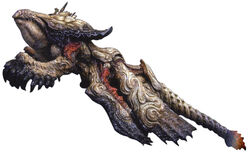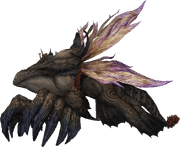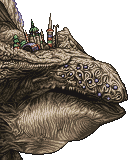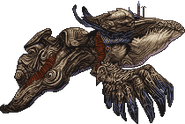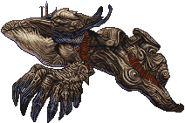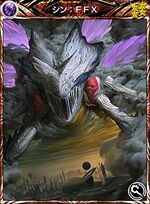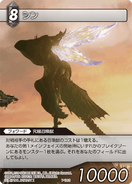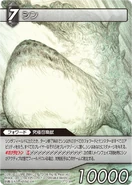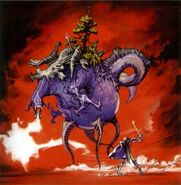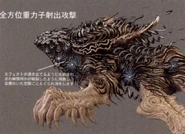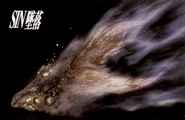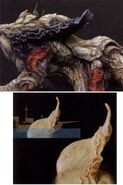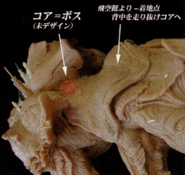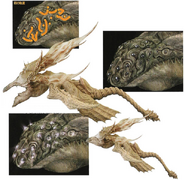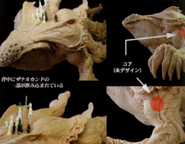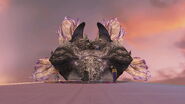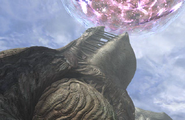Sin is our punishment for letting things get out of hand.
Wakka
Sin (シン, Shin?) is the main antagonistic force in Final Fantasy X. It is a gargantuan whale-like beast that threatens the world of Spira. It was named by the people of Spira who believed the beast came into being as punishment for their ancestors relying on machina and becoming a hedonistic society. By following the teachings of Yevon, the people of Spira believe one day they will atone for their crimes and Sin will vanish.
Sin is represented by the letter Z in the Yevon script alphabet. It appears in many places in Final Fantasy X, sometimes paired with the letter A, the symbol of Yu Yevon, symbolizing the beginning and the end of things.
Profile[]
Appearance[]
Sin has a whale-like body that it moves with a pair of clawed arms, as well as hind legs resembling pectoral fins for movement in water. It has a long tail and its body is encased in scales it can shed and turn into smaller monsters known as Sinscales. It carries part of a city, presumed to be a part of Zanarkand, on its body close to the back of the head. Sin's final form has feathery wing-like protrusions that are purple at the tips.
Abilities[]
According to Final Fantasy X Scenario Ultimania,[1] Sin's body is composed of pyreflies and in that respect it is no different from a common fiend. However, Sin draws in pyreflies to replenish its strength whenever damaged, and thus conventional attacks cannot defeat it. According to the Final Fantasy X Ultimania Omega, its body is formed as a result of gravity magic used to draw in further pyreflies from the atmosphere and compressing them densely. Sin can recover the separated parts of its own body, known as "Sinspawn", because Sin can repair its body more efficiently by taking in pyreflies that have already been condensed, rather than freshly absorbing pyreflies that drift around the surrounding areas.[1]

Sin attacks.
Sin's destructive capabilities are tremendous, as it can control gravitational forces and thus fly. People who touch Sin are sometimes carried, unharmed, to remote places. This is because Sin's body is supple and can suck up those who touched it and then expel them. People who have gotten close to Sin may get muddled up and experience hallucinations. This is called "being affected by Sin's toxin", but the true reason is that the high density of pyreflies that form Sin's body have an adverse affect on the low-density amounts of pyreflies present within the bodies of those who approach it.
Sin is immune to most conventional forms of weaponry and is highly resistant to attack, able to project a barrier to protect itself. Spirans believe that only the Final Aeon can kill Sin, and all attacks the party wages on Sin in Final Fantasy X only serve to wound it. Sin's signature attack is a huge blast of energy from its mouth known as "Giga-Graviton", an attack so powerful it can induce tectonic plate movements visible from outer space. Its other body parts are capable of using lesser Gravity-based attacks. Sin has an affinity for water, and can often be encountered lurking in such an environment. It can blend into, absorb, and use the water it inhabits as a weapon.
Whether Sin's abilities change depending on which Final Aeon forms its core is unknown. It is implied the last Sin (which Yuna fought) never reached its full strength, as the Final Aeon at its core still exerted some influence over it, slowly being taken over by Yu Yevon.
Story[]
Final Fantasy X[]
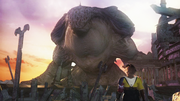
Sin in Zanarkand ruins.
Sin was created during the Machina War between Bevelle and Zanarkand a thousand years ago. Bevelle relied on machina for weaponry, while Zanarkand depended on summoners. As Zanarkand began to lose, its leader, Yu Yevon (a powerful summoner), devised a plan to defeat Bevelle and preserve his city forever. Yu Yevon called the surviving citizens of Zanarkand and transformed them into fayth, acting as conduits for a massive summoning that created a spectral version of Zanarkand, born from the dreams of its former inhabitants.
Yu Yevon set this "Dream Zanarkand" in an isolated location far out at sea and summoned pyreflies to craft the first Sin that did not have a Final Aeon at its core. Yu Yevon created Sin with three objectives: to protect the summoning of Dream Zanarkand, to keep it hidden, and to destroy any city that grew too large or relied too heavily on technology. The strain of controlling such a creature for so long shattered Yu Yevon's mind, severing any conscious control he once had. Sin became a mindless monster driven by instinct, attacking civilizations across Spira, starting with the true Zanarkand. Yu Yevon was reduced to a mere husk, existing solely to summon.
To grant Spira a reprieve and a hope for salvation, Yu Yevon's daughter, Yunalesca, devised a plan to destroy Sin using a method known as the Final Aeon—a powerful entity born from a bond of love. Yunalesca sacrificed her husband, Zaon, for the ritual, making him the first Final Aeon, which succeeded in destroying Sin, claiming Yunalesca's life in the process. Yu Yevon's spirit then possessed Zaon's aeon form, gradually transforming it into a new Sin. During this transformation, the new Sin remained too weak to terrorize, establishing a temporary period of peace known as the Calm.
Becoming an unsent, Yunalesca remained in the Zanarkand Dome as the only one capable of creating the Final Aeon for summoners who completed their pilgrimage. According to the Final Fantasy X Ultimania Omega, during the first Calm, Spira's survivors began rebuilding, centering their efforts on Bevelle. Once Yu Yevon regenerated Sin, Spira's plight began anew. This second incarnation of Sin obliterated the remaining machina civilizations, leading to the decline and subsequent banning of machina use throughout Spira.
The Yevon temple was founded in Bevelle, establishing the tradition of venerating Yevon and Yunalesca. These teachings, along with the prohibition of machina, were gradually adopted across Spira. Capitalizing on public sentiment, the temples gained control by shaping a new religion that framed Sin as divine punishment for humanity's sins. They propagated the belief that the Calm, brought about by the Final Summoning, offered salvation. The temples shifted the blame for Sin's return onto the people, and maintained order by fostering hope that atonement would one day banish Sin permanently. In reality, Yunalesca and the temple leaders knew Sin would always return, but their doctrine gave Spira hope and prevented its citizens from falling into despair.
Around six hundred years later, a summoner named Gandof defeated Sin, tearing the Calm Lands asunder and isolating Remiem Temple, thus ushering in the second Calm and becoming the first high summoner. Like Yunalesca, Gandof perished in the process. His sacrifice reinforced the teachings of Yevon, and any doubts about the temples subsided. As with previous Calms, this one was short-lived. Yu Yevon again regenerated Sin, unleashing a third iteration with Gandof's Final Aeon as its core, which resumed its destructive rampage across Spira.
Gandof's posthumous title of "high summoner" became a designation thereafter bestowed upon all who defeated Sin. Statues of Gandof were placed in Yevon's temples, and his story was shared across Spira as a model of honor and sacrifice. To follow his example, summoners embarked on pilgrimages, traveling to each of Yevon's temples to pray to the fayth and acquiring powerful aeons in preparation for obtaining the Final Aeon in Zanarkand before confronting Sin.
This cycle continued for hundreds of years—summoners would go on a pilgrimage to hone their abilities as they traveled to the ruins of Zanarkand and met Yunalesca, who would transform one of their guardians into a new Final Aeon. The summoner would give his or her life to destroy Sin with the Final Summoning, and Yu Yevon's spirit would possess the Final Aeon and turn it into a new Sin.
As Sin attacks large settlements, Spiran towns rarely grow beyond a certain size. The biggest city in Spira is Bevelle, followed by Luca, but countermeasures are taken so that those cities are not attacked by Sin by having the Crusaders attract Sin's attention and avert its course.

Sin appears in Lake Macalania.
Braska, Jecht, and Auron are the most recent band of summoner and guardians to defeat Sin. They made their way to Yunalesca and Braska obtained the Final Aeon. Though Braska held onto the hope that this time Sin would not return, Auron believed otherwise. Jecht, originally a citizen of Dream Zanarkand who had accidentally ended up in Spira, became Braska's Final Aeon. Before this, he tasked Auron with finding a way to Dream Zanarkand and taking care of his son, Tidus. The Final Summoning killed Braska and Jecht became the new Sin.
Ten years later, Jecht, still aware within Sin, although only barely, brings Sin to Dream Zanarkand, and he and Auron take Tidus into the world of Spira. As Tidus travels with Braska's daughter Yuna as her guardian, Auron accompanies them and teaches Tidus about Jecht and Braska. Tidus is made aware of Jecht's spirit resting within Sin, and is told Jecht wants Tidus to kill him to free him from his fate of terrorizing the world. They run into Sin many times and witness the destruction it brings forth.
When the party confronts Yunalesca, she tells them the Final Aeon would not destroy Sin permanently, but Braska chose this path to give the people of Spira hope. Yuna disagrees, saying her father believed he could free Spira. Denouncing the tradition as false hope, Yuna refuses to sacrifice one of her guardians. Yuna and her guardians destroy Yunalesca, and with her, the way to create a new Final Aeon.
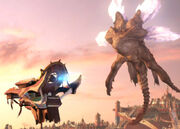
Sin faces off against the airship.
Now made aware of Yu Yevon's existence, Tidus suggests a new way to destroy Yu Yevon's spirit within Sin. The party wages a full scale attack on Sin with the airship, Fahrenheit, and enters its mouth. In the deepest part of Sin, they find a recreation of Dream Zanarkand in ruins, where Jecht awaits them. The party destroys Jecht in his Final Aeon form and Yu Yevon emerges.
Yuna calls her aeons one by one and Yu Yevon possesses them, and the party destroys them as well. With no aeons left to control, Yu Yevon becomes vulnerable and is killed. Yuna performs a sending to place his spirit at rest. With Yu Yevon's defeat, Sin explodes, and the Eternal Calm begins.
Final Fantasy X -Will-[]
The Farplane has become unstable to the point that beckoning outside of it manifests the dead in Spira. Sin returns, ending the Eternal Calm, and Yuna theorizes it was the result of someone beckoning it. She delivers a speech to a crowd of people announcing she will defeat it once more.
Gameplay[]
Inside Sin[]
The inside of Sin, aptly known as Inside Sin, is the final dungeon. The party enters inside the beast after having penetrated its armor, and make their way to the center where they face Braska's Final Aeon, and eventually, Yu Yevon. The fiends within Sin are powerful, but if the player defeats them they gain valuable AP.
Sinspawn[]
Sin can create smaller creatures, Sinspawn, from its outer layer. Coming in a variety of shapes and levels of power, the Sinspawn cause trouble for any person that crosses them until Sin arrives and reabsorbs them.
- Sinscales: Generic Sinspawn.
- Ammes: A sea anemone-like Sinspawn.
- Echuilles: A jellyfish-like Sinspawn.
- Geneaux: A Sinspawn found at the entrance of Kilika Temple, hiding inside a tough shell.
- Gui: A fusion of various Sinspawn gathered by the Crusaders for Operation Mi'ihen.
- Genais: The absolute strongest Sinspawn, with the same shape as Geneaux.
Boss[]
Sin's various body parts are faced several times during the game.
Other appearances[]
Final Fantasy Airborne Brigade[]
Around January-February 2013, Sin was one of the opponents available.[2][3]
Final Fantasy Record Keeper[]
Mobius Final Fantasy[]
Sin appeared as the Supreme card Sin: FFX. It was a dark-attribute, mage-type Supreme card that granted the ability Giga-Graviton when equipped. It would hit all enemies on the field multiple times for dark-attribute damage. The card possessed the unique extra ability Ultra Guard Breaker that allowed it to deal full damage while ignoring any resistances the target may have had (unless they absorb the attack).
Final Fantasy Trading Card Game[]
Sin appears and is represented by Dark-elemental cards. He is depicted in a screenshot from a Final Fantasy X FMV and a Yoshitaka Amano artwork.
Other media[]
Although Sin does not have a direct appearance in either Dissidia Final Fantasy or Dissidia 012, it was given an indirect reference in the latter game when the player has Yuna fight Kefka Palazzo, as the latter will childishly beg for Yuna to summon the destroyer.
Behind the scenes[]
Sin as a force of nature[]
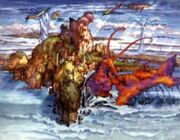
Early concept art depicting a Sin prototype.
Sin was created to be a presence Spirans could not avoid however much they tried. Director Yoshinori Kitase created it to represent the kinds of calamitous disasters that exist in the real world, such as earthquakes and typhoons.[4] Spira has the teachings of Yevon, which give meaning to people's lives in the face of death, so what Kitase really tried to show in Final Fantasy X, was how people behave in the face of unavoidable fate.[5] Having ruins become a part of Sin's physical form helped to visually cement the idea that Sin an "unimaginably ancient monster on an unprecedented scale". Sin's broad physical shape is modeled after a whale to give the impression of the being's size, as well as its intelligence and otherworldliness.[5]
When asked why Sin was brought back in Final Fantasy X -Will-, Kitase commented that similar to how Sephiroth's role in Final Fantasy VII, Sin plays an important role in Final Fantasy X and the developers wanted to keep Sin involved with the story. "We can't say what happens to Sin after the radio drama, we wanted to leave something up to the player's imagination."[4]
As Sin was designed to represent natural disasters from the sea such as typhoons, tsunami, and earthquakes, the time period without Sin is called a Calm (Nagisetsu, ナギ節?). Nagi (凪?) is a term used by Japanese fishermen and mariners to describe the state of calm wind.
Regarding the Buddhist undertones of Yevon and its history, Sin's occurrence is similar to teachings and beliefs of Nichiren Buddhism, which is a sect of Japanese Buddhism with greater similarities to more hardline dualism and rigid faith found in Christianity and Abrahamic religions. Its founder and preacher, Nichiren, insisted the four other branches of Japanese Buddhism—Tendai, Zen, Shingon, and Ritsu—led the people astray by their various practices, and were rooted in one of the greatest infractions in Buddhism: division of the faith into sects. Made during the Mid Kamakura Era, during the times of the Genpei Wars, the Mongol invasions, and the turbulent recovery of the nation after the nadir of the late Heian Era, Nichiren claimed that while the other four schools were destroying the nation, his sect would calm the kami of Japan and ensure an eternal national peace without war or national disasters once strictly adhered to. Garnering many enemies within the public and the government, Nichiren was sent to live in exile and was downtrodden for the rest of his life. His faith later became influential for its promise of immanent enlightenment and teachings of self integrity and personal responsibility. While the Middle Way of Buddhism is demonstrated in all of Spira learning to come together despite everyone's differences through the resolve of mankind, Sin and its perpetrators can further be seen as both the evils and hypocrisy of the past, as well as its manifestation into bad karma by haunting disaster and calamity of many forms.
Mythological and literary allusions[]
The plot of Final Fantasy X has comparisons to the famous Japanese story of Susanoo and the Yamata-no-Orochi. Susanoo (Tidus) is banished from his home in the Heavens (Dream Zanarkand) and trying to win back favor to return home. He comes to the mortal world (Spira) and comes across two earthly deities who are weeping because they have to sacrifice their daughters (summoners) to the evil Yamata-no-Orochi (Sin) to keep it from destroying their home. They wish to save their eighth daughter (Yuna) from being devoured, so Susanoo comes up with a plan that involves getting the dragon-snake drunk with sake ("Hymn of the Fayth") and killing it in its drunken state.
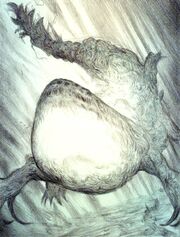
A frontal image of Sin as drawn by Yoshitaka Amano.
"Yamata-no-Orochi" literally means "8-branched giant snake" and is often translated as the Eight-Forked Serpent in English. It is a legendary 8-headed and 8-tailed Japanese dragon, and gigantic enough to span large expanses of land. Early concept artwork for Final Fantasy X show serpentine or octopus-like Sin prototypes with multiple appendages.
Sin also resembles the Leviathan, a sea monster from the Old Testament, and the word itself has become synonymous with any large sea monster, in Modern Hebrew simply meaning "whale". The Biblical Leviathan would live in the ocean depths meting out judgment. According to Christian demonology, Leviathan rules over the sin of envy, the worst of the Seven Deadly Sins for being a sin done out of deliberation over impulse or ignorance. While Yu Yevon's motives are ambiguous, his actions imply bitterness over his decline in power, resentment against the advancement that came to overshadow him and toward a world that would move on without him. While Sin is not a fiend, Sin can be compared to one: restless souls turned monstrous due to their envy of the living.
Sin is reminiscent of Vritra, who in Hindu mythology was an asura created by artisan god and creator of mankind, Tvashtr, to become the enemy of Indra after escalating incidents between them. Vritra became the violent leader of the asuras, and he become large as the universe and enough to swallow it whole, bringing its inhabitants in terror. In one tale, Indra sliced Vritra from the inside out after Vritra swallowed him whole with a vajra, a weapon symbolic of the truth, while in others, Indra destroyed Vritra with sea foam at twilight, or was destroyed by Saraswati, the goddess of music, knowledge, and bodies of water. With envy as a theme for Final Fantasy X's antagonists, asuras are known to be ruled by envy within Hindu and Buddhist mythology, being the reincarnation of violent and forcefully ambitious individuals, and in turn, symbolic of never-ending conflict. Vritra is believed to help define the more bestial and feral of asura as gargantuan beings associated with voracity and primordial and chthonic leanings, akin to the aforementioned Yamata no Orochi, Charybdis, or to even kaiju.
Sin's appearance could also have been inspired by the Moby-Dick, book by Herman Melville. Moby-Dick represents many things: an unknowable and inscrutable god or madness incarnate. To different people it symbolizes true evil or "a dumb brute…that smote thee from blindest instinct!" or a power that controls and limits mankind.
Gallery[]
Etymology[]
In a religious context, sin is the act of violating God's will. Sin can also be viewed as anything that violates the ideal relationship between an individual and God; or as any diversion from the perceived ideal order for human living. To sin has been defined as "to miss the mark".
Citations[]
- ↑ 1.0 1.1 (n.d.) . "The Nature of Sin". From AuronLu. Archived from the original on 8 November, 2020.
- ↑ http://www.siliconera.com/2013/02/15/sin-has-been-resurrected-for-final-fantasy-airborne-brigade/
- ↑ https://www.youtube.com/watch?v=PUpqN1Mn9eY
- ↑ 4.0 4.1 Why Is The Final Fantasy X World Melancholy After Final Fantasy X-2? (Accessed: July 10, 2020) at Siliconera
- ↑ 5.0 5.1 Final Fantasy 10: Kitase reveals the secrets of its success (dead) (Accessed: March 05, 2014) at gamestm (dead)

